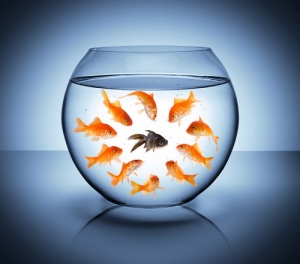Some years ago I launched into a PhD on the phenomena of mental illness prejudice and discrimination.
I was initially confused about why the mentally ill experienced “stigma” and other minority groups experienced “prejudice” or “discrimination”. I was quite taken back to find that other minority groups experienced an ism but not those with mental illness! I found lots of isms such as sexism, weightism, ageism and no psychism!
What is discrimination versus prejudice?
My Phd that I did not complete was in the area of social psychology. My business plans unfortunately prevented me from finishing.
Within social psychology prejudice refers to the negative emotions and feelings towards another social group; discrimination refers to the negative actions or behaviours towards another group.
Stigma isn’t that easy to measure so I just ditched that idea. Stigma refers to the negative social attitudes of society. In my opinion, the negative opinions of the majority were not as interesting as measuring how individuals learned discrimination and prejudice, and how they did it to others. My quest was to find ways to prevent discrimination altogether by learning about the social cognitive mechanisms that fuelled discriminatory emotions, thoughts and actions.
Why does discrimination occur?
Young children are vulnerable and the ability to discriminate between a familiar face and a stranger occurs in infants at around 9 months.
By the age of 5 years, girls are able to label that a successful individual is a “he” and have learned that they are female and not male.
In primitive tribal cultures, the ability to identify your safe social group would have helped children to avoid harm in times when society was not developed with a social justice system. A young girl would be most safe being around women from her own tribe, and to not know this would have put her a risk of harm.
It is easy to see that the ability to socially identify gender, age, occupational roles and culture is very important as there are many complex social rules around how to treat others. The ability to socially discriminate is a key learning phase in a child’s development. To be able to categorise is about belonging, safety and developing relationships with others that share your beliefs and your world.
The problem that occurs is when the act of social discrimination moves from being a way to work out “who your people are” to those who are not in your social group. Often minority social groups will label the majority with similar negative labels, as a way to feel that the minority is special and a safe group to belong to. Labelling minorities and labelling majority groups is the way that the media plays with news articles to make you read and feel sufficiently threatened to read on. The more that the media can make you feel unsafe, the more you will want to read and seek information on the social group that scares you.
The simple cause of discrimination is fear. Fear of being hurt, fear of losing a way of life, fear of losing control, fear of strangers and those that are different.
What is Labelling?
Labelling occurs when we have social group with a stereotype. Labels can be good or bad. Being a “sick person” gives the person permission to reduce their workload, seek help from others and to be given a period of time to recover. Negative labelling reinforces a known stereotype. What I have found to be most interesting is that verbal discrimination is rather simple. Negative labels will nearly always include a reference to the social group being:
- Dangerous – and reported to be more dangerous than the majority;
- Unclean;
- Unintelligent;
Take a moment to consider the impact of recent news events and consider how interesting the articles are if you remove all content about social groups being dangerous! The reason we become upset or angry is because we imagine that our personal social group is ideal and that the other social group is demonised.
Once I saw these same 3 labels come up over, and over, and over again, it seemed to invalidate most of the news I was listening to! Unfortunately the news was no longer appealing as it sounded more like a discriminatory sales pitch than actual facts.
What are the 5 ways humans discriminate?
Allport was one of the greatest theorists on prejudice and discrimination. Allport theorised that there were 5 ways in which discrimination can occur. These 5 actions include verbal discrimination, avoidance, service denial, physical assault and extermination.
In our research we created a measure of the first 3 levels of reported discriminatory actions towards other people. Our sample of 300+ was not big enough to gain data on physical violence or murder. What we found is that verbal discrimination occurs at about double the rate of avoidance. We found that avoidance occurred at double the rate of service denial. The average person in Brisbane was often verbally discriminating, occasionally avoiding and had witnessed or participated in service denial to the minority group we were studying. I’m sure the results would have been quite similar to the rest of Australia as Brisbane is usually a pretty safe place to live. I had wondered if we had a big enough sample, if murder could be predicted from the level of verbal discrimination?
What can I do to stop discrimination?
My untested theory for my PhD would have been that interventions that decrease verbal discrimination and avoidance would have decreased service denial, physical assault and violence at a society level. Unfortunately this research was not very interesting and not funded by a scholarship, so I was unable to afford to volunteer the thousands of hours needed to finish it.
Tolerance is not enough. Tolerance means you put up with others. I’m against using the word stigma and also tolerance. It’s time we move forward and learn to become unafraid of those that may discriminate against us. To live in fear means that the we loose our freedom, not gain it.
Discrimination affects us all because we were once young and will be old. We belong to a gender which can be good or bad depending on the group you are with. We all belong to an occupation or social role that may be valued or devalued by others. Discrimination is unavoidable, but understanding it is easy!
 Author: Vivian Jarrett, B Psych (hons), AMAPS, MAICD.
Author: Vivian Jarrett, B Psych (hons), AMAPS, MAICD.
Vivian is available for individuals, community organisations or businesses who want expert help with decreasing discrimination from society, and can be booked under entrepreneurial business coaching when you call our centre.
To make an appointment try Online Booking. Alternatively, you can call M1 Psychology Brisbane on (07) 3067 9129
